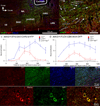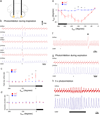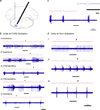Optogenetic perturbation of preBötzinger complex inhibitory neurons modulates respiratory pattern
- PMID: 25643296
- PMCID: PMC4340826
- DOI: 10.1038/nn.3938
Optogenetic perturbation of preBötzinger complex inhibitory neurons modulates respiratory pattern
Abstract
Inhibitory neurons make up a substantial fraction of the neurons in the preBötzinger complex (preBötC), a site that is critical for mammalian eupneic breathing. We investigated the role of glycinergic preBötC neurons in respiratory rhythmogenesis in mice using optogenetically targeted excitation and inhibition. Channelrhodopsin-2 (ChR2) or Archaerhodopsin (Arch) were expressed in glycinergic preBötC neurons of glycine transporter 2 (Glyt2, also known as Slc6a5)-Cre mice. In ChR2-transfected mice, brief inspiratory-phase bilateral photostimulation targeting the preBötC prematurely terminated inspiration, whereas expiratory-phase photostimulation delayed the onset of the next inspiration. Prolonged photostimulation produced apneas lasting as long as the light pulse. Inspiratory-phase photoinhibition in Arch-transfected mice during inspiration increased tidal volume without altering inspiratory duration, whereas expiratory-phase photoinhibition shortened the latency until the next inspiration. During persistent apneas, prolonged photoinhibition restored rhythmic breathing. We conclude that glycinergic preBötC neurons modulate inspiratory pattern and are important for reflex apneas, but that the rhythm can persist after substantial dampening of their activity.
Figures






Similar articles
-
Inhibitory Subpopulations in preBötzinger Complex Play Distinct Roles in Modulating Inspiratory Rhythm and Pattern.J Neurosci. 2024 Jun 19;44(25):e1928232024. doi: 10.1523/JNEUROSCI.1928-23.2024. J Neurosci. 2024. PMID: 38729762 Free PMC article.
-
Optogenetic excitation of preBötzinger complex neurons potently drives inspiratory activity in vivo.J Physiol. 2015 Aug 15;593(16):3673-92. doi: 10.1113/JP270471. Epub 2015 Jul 14. J Physiol. 2015. PMID: 26010654 Free PMC article.
-
Defining preBötzinger Complex Rhythm- and Pattern-Generating Neural Microcircuits In Vivo.Neuron. 2016 Aug 3;91(3):602-14. doi: 10.1016/j.neuron.2016.07.003. Neuron. 2016. PMID: 27497222 Free PMC article.
-
Neural mechanisms for sigh generation during prenatal development.J Neurophysiol. 2018 Sep 1;120(3):1162-1172. doi: 10.1152/jn.00314.2018. Epub 2018 Jun 13. J Neurophysiol. 2018. PMID: 29897860 Review.
-
On the central pattern generator for the basic breathing rhythmicity.J Appl Physiol Respir Environ Exerc Physiol. 1983 Dec;55(6):1647-59. doi: 10.1152/jappl.1983.55.6.1647. J Appl Physiol Respir Environ Exerc Physiol. 1983. PMID: 6363361 Review.
Cited by
-
Microcircuits in respiratory rhythm generation: commonalities with other rhythm generating networks and evolutionary perspectives.Curr Opin Neurobiol. 2016 Dec;41:53-61. doi: 10.1016/j.conb.2016.08.003. Epub 2016 Aug 30. Curr Opin Neurobiol. 2016. PMID: 27589601 Free PMC article. Review.
-
Evaluating the Burstlet Theory of Inspiratory Rhythm and Pattern Generation.eNeuro. 2020 Jan 15;7(1):ENEURO.0314-19.2019. doi: 10.1523/ENEURO.0314-19.2019. Print 2020 Jan/Feb. eNeuro. 2020. PMID: 31888961 Free PMC article.
-
Molecular Organization of Autonomic, Respiratory, and Spinally-Projecting Neurons in the Mouse Ventrolateral Medulla.J Neurosci. 2024 Jul 31;44(31):e2211232024. doi: 10.1523/JNEUROSCI.2211-23.2024. J Neurosci. 2024. PMID: 38918066 Free PMC article.
-
Breathing Rhythm and Pattern and Their Influence on Emotion.Annu Rev Neurosci. 2022 Jul 8;45:223-247. doi: 10.1146/annurev-neuro-090121-014424. Epub 2022 Mar 8. Annu Rev Neurosci. 2022. PMID: 35259917 Free PMC article. Review.
-
A novel reticular node in the brainstem synchronizes neonatal mouse crying with breathing.Neuron. 2022 Feb 16;110(4):644-657.e6. doi: 10.1016/j.neuron.2021.12.014. Epub 2022 Jan 7. Neuron. 2022. PMID: 34998469 Free PMC article.
References
-
- Stornetta RL, et al. A group of glutamatergic interneurons expressing high levels of both neurokinin-1 receptors and somatostatin identifies the region of the pre-Botzinger complex. J Comp Neurol. 2003;455:499–512. - PubMed
-
- Bouvier J, et al. Hindbrain interneurons and axon guidance signaling critical for breathing. Nat Neurosci. 2010;13:1066–1074. - PubMed
Publication types
MeSH terms
Substances
Grants and funding
LinkOut - more resources
Full Text Sources
Other Literature Sources
Research Materials

